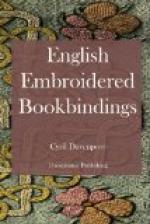This is certainly a very handsome piece of work, and is wonderfully preserved. It is the earliest example of a really fine embroidered book on velvet in existence, and it has perhaps been more noticed and illustrated than any other book of its kind. The crown has an interesting peculiarity about it, which does not appear, as far as I have observed, on any other representation of it, namely, that the four arches take their rise directly from the rim. They generally rise from the summits of the crosses-patee, but I should fancy that the rise from the circlet itself is more correct.
[Illustration: 16—Biblia. Tiguri, 1543.]
Biblia. Tiguri, 1543.
This Bible also belonged to Henry VIII. It is bound in velvet, originally some shade of red or crimson, but now much faded. It measures 15 by 9-1/4 inches. It is ornamented with arabesques and initials all outlined with fine gold cord. In the centre are the initials H. R., bound together by an interlacing knot, within a circle. Arabesques above and below the circle make up an inner panel, itself enclosed by a broad border of arabesques, with a double, or Tudor, rose in each corner. The edges of the leaves of the book are elaborately painted with heraldic designs.
It has been re-backed with leather, but still retains the original boards.
[Illustration: 17—Il Petrarcha. Venetia, 1544.]
Il Petrarcha. Venetia, 1544.
Another fine example of the decorative use of Heraldry occurs on a copy of Petrarch printed at Venice in 1544, and probably bound about 1548, after the death of Henry VIII. It belonged to Queen Katherine Parr, and bears her arms with several quarterings—worked applique on rich blue purple velvet, and measures 7 by 6 inches. The first coat is the ‘coat of augmentation’ granted to the Queen by Henry VIII.—’Argent, on a pile gules, between six roses of the same, three others of the field’—and the next coat is that of ‘Parr.’
The various quarterings on this coat are worked differently from those on the last book described. Here the red and blue are well shown by pieces of coloured satin—except in the first, fifth, and seventh coats, where there is some couched work in diamond pattern, just like that on Martin Brion’s book. The entire coat, which is of an ornamental shape, is applique in one large piece, and edged by a gold cord. The crown surmounting it is heavily worked in gold guimp—the cap being represented in crimson silk thread and all applique. There are two supporters—that on the right, an animal breathing flame, and gorged with a coronet from which hangs a long chain, all worked in coloured silks on linen and applique, belongs to the Fitzhugh family, the coat of which is shown on the third quarter; that on the left, a wyvern argent, also gorged with a coronet, from which depends a long gold chain, is that of the Parr family. The wyvern is a piece of blue silk, finished in gold and silver cords, in




